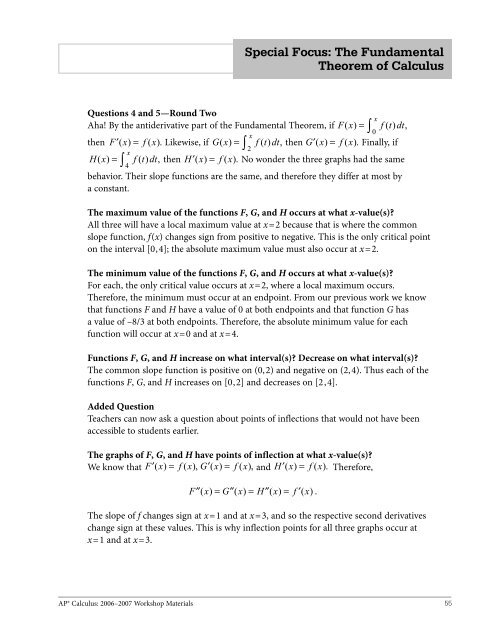AP Calculus
You also want an ePaper? Increase the reach of your titles
YUMPU automatically turns print PDFs into web optimized ePapers that Google loves.
Special Focus: The Fundamental<br />
Theorem of <strong>Calculus</strong><br />
Questions 4 and 5—Round Two<br />
x<br />
Aha! By the antiderivative part of the Fundamental Theorem, if F( x) = ∫ f ( t) dt,<br />
0<br />
x<br />
then F′ ( x) = f ( x). Likewise, if G( x) = ∫ f ( t) dt,<br />
then G′ ( x) = f ( x). Finally, if<br />
2<br />
x<br />
H( x) = ∫ f ( t) dt,<br />
then H′ ( x) = f ( x). No wonder the three graphs had the same<br />
4<br />
behavior. Their slope functions are the same, and therefore they differ at most by<br />
a constant.<br />
The maximum value of the functions F, G, and H occurs at what x-value(s)?<br />
All three will have a local maximum value at x=2 because that is where the common<br />
slope function, f(x) changes sign from positive to negative. This is the only critical point<br />
on the interval [0,4]; the absolute maximum value must also occur at x=2.<br />
The minimum value of the functions F, G, and H occurs at what x-value(s)?<br />
For each, the only critical value occurs at x=2, where a local maximum occurs.<br />
Therefore, the minimum must occur at an endpoint. From our previous work we know<br />
that functions F and H have a value of 0 at both endpoints and that function G has<br />
a value of –8/3 at both endpoints. Therefore, the absolute minimum value for each<br />
function will occur at x=0 and at x=4.<br />
Functions F, G, and H increase on what interval(s)? Decrease on what interval(s)?<br />
The common slope function is positive on (0,2) and negative on (2,4). Thus each of the<br />
functions F, G, and H increases on [0,2] and decreases on [2,4].<br />
Added Question<br />
Teachers can now ask a question about points of inflections that would not have been<br />
accessible to students earlier.<br />
The graphs of F, G, and H have points of inflection at what x-value(s)?<br />
We know that F′ ( x) = f ( x), G′ ( x) = f ( x), and H′ ( x) = f ( x). Therefore,<br />
F′′ ( x) = G′′ ( x) = H′′ ( x) = f ′( x) .<br />
The slope of f changes sign at x=1 and at x=3, and so the respective second derivatives<br />
change sign at these values. This is why inflection points for all three graphs occur at<br />
x=1 and at x=3.<br />
<strong>AP</strong>® <strong>Calculus</strong>: 2006–2007 Workshop Materials 55


